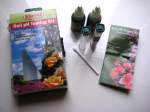Home › Garden & landscape design › Cottage garden design
Cottage Garden Design
Tips And Ideas
Cottage garden design recaptures the informal, romantic style of days gone by.
Ask just about anyone what the words 'cottage garden' conjure up and the answers will be very similar: a billowing profusion of informal perennials interspersed with bright annuals and fragrant herbs and climbers.
Throw in some fruit trees and vegetables, winding paths and rustic features, and there you have the essential cottage garden mix.
Step back in time and cottage garden design was born of economic necessity. The original cottage gardens provided fresh fruit and vegetables for the cottagers and their families, as well as fresh herbs for cooking, scenting clothes and medicinal use.
Traditionally, every inch of space was given over to planting, and lawns and other 'unproductive' spaces were rare. The plants were closely spaced with narrow paths of trodden earth separating the beds.
The original cottage garden was probably high maintenance with very little in the way of winter interest - something that few of us would find desirable these days, so the cottage garden style needs to be adapted to meet the needs of the modern gardener.
The essential elements of your cottage garden design
Design - what design?
The key to achieving a successful cottage garden design is that it doesn't look designed at all. Informality and bountiful exuberance are the watchwords.
The aim is to avoid straight lines and symmetrical layouts where possible, and use naturalistic planting schemes allowing plants to run into each other and spill over the edges of paths and surfaces.
Paths and hard surfaces
Where possible allow pathways to wind and meander through the garden allowing you to to enjoy the flowers and scents and creating unexpected vistas and viewpoints.
Soften the appearance of any straight paths by allowing plants to cascade and billow over the edges.
The same principles can be applied to hard surfaces such as seating areas.
Surfacing materials that blend in with your house work well in a cottage garden design.
- Bricks and cobbles give an authentic, rustic feel, but they can be expensive although you may be able to find a bargain at a reclamation or salvage yard.
- Paving slabs, which are available in a range of colours and finishes, are a good mid-range choice.
- Gravel is cost effective and very quick and easy to lay. Choose a colour and grade that complements your home.
Fences and gates
Again, go for the rustic look using wood. A wooden picket fence and matching gate give an authentic country feel by allowing plants and flowers to peep through the slats.
Go completely rustic by leaving the wood natural, or create the perfect foil for your planting by painting white or using a coloured stain (muted greens and blues work well).
Plant supports
Climbing plants are an integral part of any cottage garden design. Support them on wooden trellises and arches. If you are creative you may even be able to build your own structures and supports from reclaimed wood and other materials.
Simple cane wigwams, planted with sweet peas, climbing nasturtiums or even runner beans are a cheap and easy way to add vertical interest to your cottage garden beds.
Furniture
Avoid sleek contemporary furniture and maintain the romantic rustic mood by selecting traditional styles of garden furniture made from wood, painted metal or wicker.
Garden accessories
Make use of unusual and characterful objets trouves to accessorise your cottage garden and lend a vintage feel.
Anything from old galvanized buckets and earthenware chimney pots used as planters, to an antique wooden wheelbarrow leaning in a corner will be effective.
Planting
Informal and natural planting schemes are the key to a successful cottage garden. The totally random planting of the original cottage gardens is hard to maintain and can easily degenerate into a complete mess.
Instead use the technique of planting in drifts using odd numbered groups of the same plant.
Punctuate your borders with taller, spiky plants (lupins and delphiniums are good) to give a more random effect and incorporate one or more fruit trees and plenty of climbers to complete the look.
For authenticity stick to traditional favourites and choose old fashioned varieties.
For more information visit these related Garden and Landscape Design pages
Further garden and landscape design ideas and tips can be found on these pages:
Design a Garden Successfully: How to Think Like a Garden Designer
Contemporary Garden Design: 10 Must-Read Tips
Design a Garden For Outdoor Entertaining
Raised Bed Garden Design: Tips and Ideas
Patio Ideas: How To Plan The Perfect Patio
An overview of the garden and landscape design process can be found at the 'Garden and Landscape Design Guide'.
Home › Garden & landscape design › Cottage garden design
